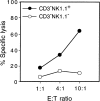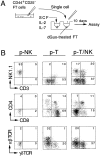Commitment of common T/Natural killer (NK) progenitors to unipotent T and NK progenitors in the murine fetal thymus revealed by a single progenitor assay
- PMID: 10587352
- PMCID: PMC2195728
- DOI: 10.1084/jem.190.11.1617
Commitment of common T/Natural killer (NK) progenitors to unipotent T and NK progenitors in the murine fetal thymus revealed by a single progenitor assay
Abstract
We have established a new clonal assay system that can evenly support the development of T and natural killer (NK) cells. With this system, we show that all T cell progenitors in the earliest CD44(+)CD25(-)FcgammaRII/III(-) fetal thymus (FT) cell population retain NK potential, and that the NK lineage-committed progenitors (p-NK) also exist in this population. T cell lineage-committed progenitors (p-T), which are unable to generate NK cells, first appear at the CD44(+)CD25(-) FcgammaRII/III(+) stage in day 12 FT. The proportion of p-T markedly increases during the transition from the CD44(+)CD25(-) stage to the CD44(+)CD25(+) stage in day 14 FT. On the other hand, p-NK preferentially increase in number at the CD44(+)CD25(-) stage between days 12 and 14 of gestation. The production of p-NK continues up to the CD44(+)CD25(+) stage, but ceases before the rearrangement of T cell receptor beta chain genes. It was further shown that the CD44(+)CD25(-) CD122(+) population of day 14 FT exclusively contains p-NK. These results indicate that the earliest T cell progenitor migrating into the FT is T/NK bipotent, and strongly suggest that the bipotent progenitor continuously produces p-NK and p-T until the CD44(+)CD25(+) stage.
Figures









References
-
- Herberman R.B., Reynolds C.W., Ortaldo J.R. Mechanism of cytotoxicity by natural killer (NK) cells. Annu. Rev. Immunol. 1986;4:651–680. - PubMed
-
- Lanier L.L., Spits H., Phillips J.H. The developmental relationship between NK cells and T cells. Immunol. Today. 1992;13:392–395. - PubMed
-
- Herberman R.B., Nunn M.F., Lavrin D.H. Natural cytotoxic reactivity of mouse lymphoid cells against syngeneic and allogeneic tumors. II. Characterization of effector cells. Int. J. Cancer. 1975;16:230–239. - PubMed
-
- Rodewald H.R., Moingeon P., Lucich J.L., Dosiou C., Lopez P., Reinherz E.L. A population of early fetal thymocytes expressing FcγRII/III contains precursors of T lymphocytes and natural killer cells. Cell. 1992;69:139–150. - PubMed
Publication types
MeSH terms
Substances
LinkOut - more resources
Full Text Sources
Other Literature Sources
Medical
Miscellaneous

